Kalka–Shimla railway
| Kalka–Shimla railway | |
|---|---|
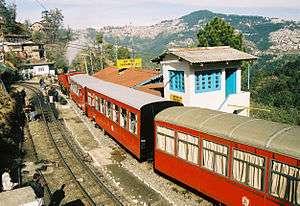 At the Taradevi station | |
| Terminus | Shimla |
| Commercial operations | |
| Built by | H. S. Harington |
| Preserved operations | |
| Operated by | Northern Railway |
| Stations | 18 |
| Length | 96 km |
| Preserved gauge | 2 ft 6 in (762 mm) |
| Commercial history | |
| Opened | 1898 |
| Preservation history | |
| Headquarters | Shimla |
| UNESCO World Heritage site | |
| Location | Himachal Pradesh, India |
| Part of | Mountain Railways of India |
| Criteria | Cultural: (ii)(iv) |
| Reference | 944ter-003 |
| Inscription | 1999 (23rd Session) |
| Extensions | 2005, 2008 |
| Area | 79.06 ha (0.3053 sq mi) |
| Buffer zone | 74.88 ha (0.2891 sq mi) |
| Coordinates | 30°51′8″N 76°56′15″E / 30.85222°N 76.93750°ECoordinates: 30°51′8″N 76°56′15″E / 30.85222°N 76.93750°E |
 Location of Kalka–Shimla railway in India | |
The Kalka–Shimla railway is a 2 ft 6 in (762 mm) narrow-gauge railway in North India which traverses a mostly-mountainous route from Kalka to Shimla. It is known for dramatic views of the hills and surrounding villages. The railway was built in 1898 to connect Shimla, the summer capital of India during the British Raj, with the rest of the Indian rail system. During its construction, 107 tunnels and 864 bridges were built along the route. The project's chief engineer was H. S. Harington.
Its early locomotives were manufactured by Sharp, Stewart and Company. Larger locomotives were introduced, which were manufactured by the Hunslet Engine Company. Diesel and diesel-hydraulic locomotives began operation in 1955 and 1970, respectively.
On 8 July 2008, UNESCO added the Kalka–Shimla railway to the mountain railways of India World Heritage Site.[1]
History
Shimla (then spelt Simla), settled by the British shortly after the first Anglo-Gurkha war, is located at 7,116 feet (2,169 m) in the foothills of the Himalayas. It became the summer capital of British India in 1864, and was the headquarters of the British army there. Before the railway was built, communication with the outside world was by cart.[2]
The 1,676 mm (5 ft 6 in) broad-gauge Delhi–Kalka line opened in 1891.[3] Construction of the Kalka–Shimla railway on 2 ft (610 mm) narrow-gauge tracks was begun by the Delhi-Ambala-Kalka Railway Company in 1898.[2] The 96.54 km (59.99 mi) line opened for traffic on 9 November 1903.[2] and was dedicated by Viceroy Lord Curzon.[4]
Because of high capital and maintenance costs and difficult working conditions, the railway was allowed to charge higher fares than on other lines. Nevertheless, the company was still unprofitable, and was purchased by the government on 1 January 1906 for Rs171,107,748. The line had been regauged to 2 ft 6 in (762 mm) the previous year in accordance with Indian War Department standards.
In 2007, the Himachal Pradesh government declared the railway a heritage property.[5] For about a week, beginning on 11 September 2007, a UNESCO team visited the railway to inspect it for possible selection as a World Heritage Site. On 8 July 2008, it became part of the mountain railways of India World Heritage Site[6] with the Darjeeling Himalayan and Nilgiri Mountain Railways.[7]
Operators
The KSR and its assets, including the stations, line and vehicles, belong to the government of India under the Ministry of Railways. The Northern Railway handles day-to-day maintenance and management, and several programs, divisions and departments of Indian Railways are responsible for repairs.
Rolling stock
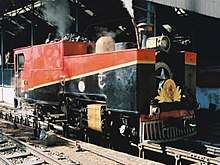
The first locomotives were two class-B 0-4-0STs from the Darjeeling Himalayan Railway. These were built as 2 ft (610 mm)-gauge engines, but were converted to 2 ft 6 in (762 mm)-gauge in 1901. They were not large enough (they were sold in 1908), and were followed in 1902 by 10 slightly-larger engines with a 0-4-2T wheel arrangement. The locomotives weighed 21.5 long tons (21.8 t; 24.1 short tons) each, and had 30 in (762 mm) driving wheels and 12 in × 16 in (304.8 mm × 406.4 mm) cylinders. Later classified as B-class by the North Western State Railway, they were manufactured by the British Sharp, Stewart and Company.[8]
Thirty larger 2-6-2T locomotives, with slight variations, were introduced between 1904 and 1910. Built by the Hunslet Engine and North British Locomotive Companies, they weighed about 35 long tons (36 t; 39 short tons) and had 30 in (762 mm) drivers and 14 in × 16 in (355.6 mm × 406.4 mm) cylinders. Later classed K and K2 by the North Western State Railway, they handled most of the rail traffic during the steam era. A pair of Kitson-Meyer 2-6-2+2-6-2 articulated locomotives, classed TD, were supplied in 1928. However, they quickly fell into disfavour because it often took all day for enough freight to be assembled to justify operating a goods train hauled by one of these locomotives. Shippers looking for faster service began turning to road transport. These 68-long-ton (69.09 t; 76.16-short-ton) locomotives were soon transferred to the Kangra Valley Railway, and were converted to 1,000 mm (3 ft 3 3⁄8 in) metre gauge in Pakistan.[8] Regular steam-locomotive operation ended in 1971.
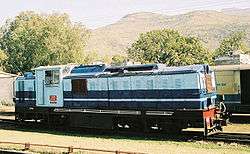
The railway's first diesel locomotives, class ZDM-1 manufactured by Arnold Jung Lokomotivfabrik (articulated with two prime movers), began operating in 1955; they were regauged, reclassified as NDM-1 and used on the Matheran Hill Railway during the 1970s. In the 1960s, class ZDM-2 locomotives from Maschinenbau Kiel (MaK) was introduced; they were later transferred to other lines.
The KSR currently operates with class ZDM-3 diesel-hydraulic locomotives (522 kW or 700 hp, 50 km/h or 31 mph), built between 1970 and 1982 by Chittaranjan Locomotive Works with a single-cab road-switcher body.[9] Six locomotives of that class were built in 2008 and 2009 by the Central Railway Loco Workshop in Parel, with updated components and a dual-cab body providing better track vision.[10]
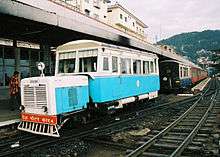
The railway opened with conventional four-wheel and bogie coaches. Their tare weight meant that only four bogie coaches could be hauled by the 2-6-2T locomotives. In a 1908 effort to increase capacity, the coach stock was rebuilt as 33-by-7-foot (10.1 by 2.1 m) bogie coaches with steel frames and bodies. To further save weight, the roofs were made of aluminium. The weight savings meant that the locomotives could now haul six of the larger coaches. This was an early example of the use of aluminium in coach construction to reduce tare weight.[2]
Goods rolling stock was constructed on a common 30-by-7-foot (9.1 by 2.1 m) pressed-steel underframe. Open and covered wagons were provided, with the open wagons having a capacity of 19 long tons (19.30 t; 21.28 short tons) and the covered wagons 17.5 long tons (17.8 t; 19.6 short tons).[2]
Route
Kalka–Shimla railway | |||||||||||||||||||||||||||||||||||||||||||||||||||||||||||||||||||||||||||||||||||||||||||||||||||||||||||||||||||||||||||||||||||||||||||||||||||||||||||||||||||||||||||||||||||||||||||
|---|---|---|---|---|---|---|---|---|---|---|---|---|---|---|---|---|---|---|---|---|---|---|---|---|---|---|---|---|---|---|---|---|---|---|---|---|---|---|---|---|---|---|---|---|---|---|---|---|---|---|---|---|---|---|---|---|---|---|---|---|---|---|---|---|---|---|---|---|---|---|---|---|---|---|---|---|---|---|---|---|---|---|---|---|---|---|---|---|---|---|---|---|---|---|---|---|---|---|---|---|---|---|---|---|---|---|---|---|---|---|---|---|---|---|---|---|---|---|---|---|---|---|---|---|---|---|---|---|---|---|---|---|---|---|---|---|---|---|---|---|---|---|---|---|---|---|---|---|---|---|---|---|---|---|---|---|---|---|---|---|---|---|---|---|---|---|---|---|---|---|---|---|---|---|---|---|---|---|---|---|---|---|---|---|---|---|---|
| |||||||||||||||||||||||||||||||||||||||||||||||||||||||||||||||||||||||||||||||||||||||||||||||||||||||||||||||||||||||||||||||||||||||||||||||||||||||||||||||||||||||||||||||||||||||||||
The railway was built to connect Shimla, the summer capital of India during the British Raj, with the Indian rail system. Shimla is now the capital of Himachal Pradesh, and Kalka is a town in the Panchkula district of Haryana.
Stations
The route winds from the Himalayan Shivalik Hills foothills at Kalka, past Dharampur, Solan, Kandaghat, Taradevi, Barog, Salogra, Totu (Jutogh) and Summerhill, to Shimla at an altitude of 2,076 meters (6,811 ft).[11]
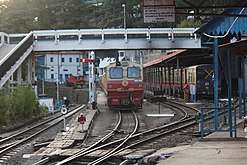 A narrow gauge train standing at the Shimla Railway Station
A narrow gauge train standing at the Shimla Railway Station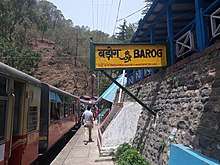 Barog
Barog- Solan
.jpg) Shimla
Shimla
Bridges and tunnels
The railway has 864 bridges and a ruling gradient of 1 in 33, or three percent. It has 919 curves, and the sharpest is 48 degrees (a radius of 122.93 feet or 37.47 m). Climbing from 656 meters (2,152 ft), the line ends at an elevation of 2,076 meters (6,811 ft) in Shimla—a difference in height of 1,420 meters (4,660 ft). It originally used 42 lb/yd (20.8 kg/m) rail, which was later replaced with 60 lb/yd (29.8 kg/m) rail.[2] One hundred seven tunnels were originally built, and 102 remain in use.
 Crossing a bridge
Crossing a bridge- Tunnel near Solan
.jpg) Tunnel near Jutogh
Tunnel near Jutogh
Trains
- Shivalik Deluxe Express: Ten coaches, with chair cars and meal service
- Kalka Shimla Express: First and second class and unreserved seating
- Himalayan Queen: Connects at Kalka with the express mail of the same name and the Kalka Shatabdi Express to Delhi.
- Kalka Shimla Passenger: First and second class and unreserved seating
- Rail Motor: First-class railbus with a glass roof and a front view
- Shivalik Queen: Ten-carriage luxury fleet. Each carriage accommodates up to eight people and has two toilets, wall-to-wall carpeting and large windows. Available through IRCTC's Chandigarh office.
Television
BBC Four televised Indian Hill Railways, a series of three programmes[12] which featured the KSR in its third episode, in February 2010; the first two episodes covered the Darjeeling Himalayan and Nilgiri Mountain Railways. The episodes, directed by Tarun Bhartiya, Hugo Smith and Nick Mattingly respectively, were produced by Gerry Troyna. Indian Hill Railways won a Royal Television Society award in June 2010.[13] The KSR was also featured in the Punjab episode of CNN's Anthony Bourdain: Parts Unknown. In 2018, the KSR was included in an episode of the BBC Two programme Great Indian Railway Journeys.[14]
References
- ↑ "Mountain Railways of India". UNESCO World Heritage Centre. Retrieved 2006-04-30.
- 1 2 3 4 5 6 "Engineer" journal article, circa 1915, reprinted in Narrow Gauge & Industrial Railway Modelling Review, no. 75, July 2008
- ↑ "IR History: Early Days II (1870-1899)". IRFCA. Retrieved 26 January 2014.
- ↑ "Archived copy". Archived from the original on 31 March 2014. Retrieved 30 March 2014.
- ↑ "HP declares Kalka–Shimla railway as 'heritage' property". The Hindu. 2007-08-13. Archived from the original on 27 September 2008. Retrieved 2007-08-13.
- ↑ "Kalka–Shimla railway makes it to Unesco's World Heritage list". The Hindu Business Line. 9 July 2008. Archived from the original on 25 June 2009. Retrieved 10 July 2008.
- ↑ http://www.outlookindia.com/pti_print.asp?id=494079%5Bpermanent+dead+link%5D
- 1 2 Hughes, Hugh 1994 Indian Locomotives Pt. 3, Narrow Gauge 1863–1940. Continental Railway Circle.
- ↑ Description of narrow-gauge diesel locomotives by IRFCA
- ↑ Central Railway: NG Loco for Kalka Simla, NR
- ↑ Khanna, Ruchika M. (5 June 2003). "Whistling through woods, the romance continues". The Tribune, Chandigarh. Retrieved 2012-08-15.
- ↑ "Indian Hill Railways". BBC. Retrieved 28 February 2010.
- ↑ "Documentary on Hill railways of India bags UK award". Express India. Archived from the original on 10 October 2012. Retrieved 19 September 2010.
- ↑ "Great Indian Railway Journeys". BBC. Retrieved 20 March 2018.
External links
| Wikimedia Commons has media related to Kalka–Shimla Railway. |
